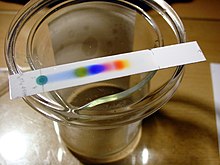This technique was first used for
- separation of colours
- crime scene investigations
- Separation of amino acids
- detecting alcohol levels in blood
- purifing chemicals
- 1
Chromatography is a separation process involving two phases, one stationary and the other mobile.
1. Chromatography is mainly used in separation and identification of components of a mixture, and to measure the purity of a given sample or synthesized product. Chromatography is the most significant method for separation of organic substances as in Thin Layer Chromatography (TLC) , High-performance liquid Chromatography(HPLC), along with Electrophoresis, is most widely used for biological substances.Chromatographic separation of protein mixtures has become one of the most effective and widely used means of purifying individual proteins.
2. Chromatography also has its wide use in forensic analysis for identification purposes and in toxicology to identify different drugs of abuse, alcohol abuse and poisoning.
-------------------
Detailed insight
1. To solve crime cases:
It may also be used to analyze samples taken from crime scenes to find out if any unusual substances are present that might indicate where something came from or where someone may have been prior to entering the crime scene.
For example, If say a lipstic stain was found on a pillow at a murder scene and some lipstick was taken from two suspects the chemist would want to know who's lipstick was found on the pillow. Chromatography would allow this. The chemist would dissolve a small piece of each of the two lipsticks and a sample found on the pillow. They would then use chromatography to compare each of the chromatograms. Each sample will provide a unique chromatogram (like a fingerprint). But if one was exactly the same as the chromatogram produced from the pillow stain then we have a poitive identification. And we found our murderer!
2. In Toxicology
The area of toxicology involves testing for the use of illegal substances, poisons and alcohol. When people go in for drug tests, their urine may be analyzed using chromatography to determine if they have drugs or drug byproducts in their urine. In forensic pathology, a sample may be analyzed to determine what chemicals are present in the dead body and possibly indicate if there is a poisonous substance present that may have killed them, or whether they were on drugs or drunk at the time of their death.The essential testing device in the toxicology department is Gas chromatography.
3. TLC
Thin layer chromatography (TLC) is a chromatography technique used to separate non-volatile mixtures. Thin layer chromatography is performed on a sheet of glass, plastic, or aluminium foil, which is coated with a thin layer of adsorbent material, usually silica gel, aluminium oxide, or cellulose. This layer of adsorbent is known as the stationary phase.
 Separation of black ink on a TLC plate.
Separation of black ink on a TLC plate.
- 0

